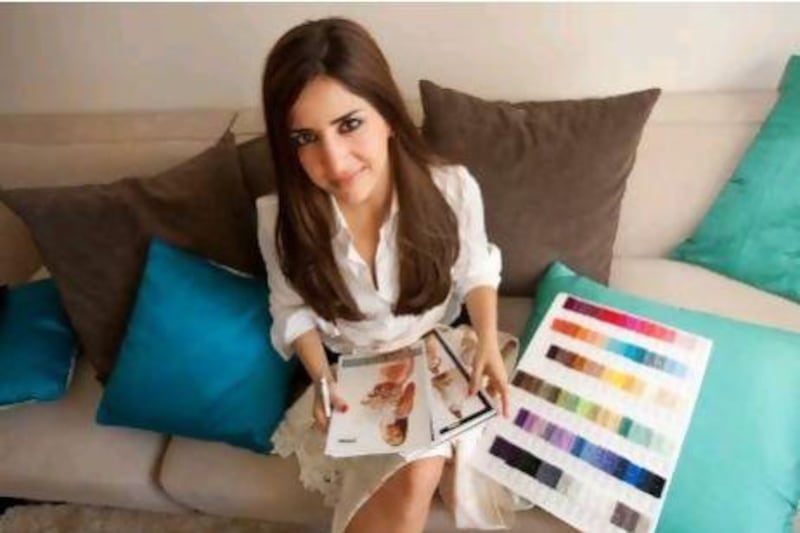We take a stroll down memory lane with three well-known, locally based designers who share their earliest Eid outfit recollections and what they'll be wearing this year.
Sara Al Madani
Designer and co-founder of Rouge Couture in Dubai (www.rouge-couture.com)
Past:
"I have memories of what my grandmother, mother and aunt used to wear for Eid. Their dresses were festive and bright in colour. They were also very detailed, with lots of work on the hands and neck area.
The abayas they would wear over their Eid clothes were always very simple, and taken off immediately when all the women gathered together.
As for me, I would be dressed in a matching version of whatever my mother wore! I remember one outfit from when I was about 14. It was red with a shade of orange and a bit of blue. There was a great deal of handwork in gold thread - or Telli - on the front.
The length was shorter at the front, lower at the back. And I wore trousers underneath the dress which were tapered at the ankle and again had plenty of embroidery to match the dress.
I remember there being many geometric patterns and nature-inspired motifs for Eid. There's a specific tree, for example, that grows in the desert and its leaves often featured prominently."
Present:
"Today, it's a totally different story and if you haven't ordered your outfit a couple of months in advance, you'll be out of luck. Now the colours are much warmer and the clothes are more couture. I mean, people are wearing Ellie Saab for Eid these days! Our country's tastes and education about fashion has evolved greatly and even older ladies are changing their styles. Nowadays, you might see ladies just wearing a simple abaya and Eid fashion appears less important than it was before. But I also see a lot of mixing of the traditional and modern; a Chanel-inspired dress underneath a classic abaya, for example - but with the pattern/detailing remaining traditional.
We certainly don't match our mothers anymore and yes, I may be wearing spikes and leather on my outfit this year. In fact, I can assure that 90 per cent of my family will be wearing Rouge Couture, too!"
Aiisha Ramadan
Dubai-based ready-to-wear, couture and bridal designer (www.aiisha.com)
Past:
"Shopping for Eid was the best! It had to be completely new attire from head to toe and the biggest part was sleeping with the clothes under, or next to me, in the bed.
When I was around eight or nine, I went in for a lot of 1960s styles and floral designs. I remember a dark purple dress in particular, made of cotton. It was heavily printed with flowers and had a matching corduroy vest.
A few years later, I made a semi-fitted dress in turquoise crepe. It came to just above the knee and had short sharp shoulders with shoulder-pads. I also made a little collar for it and added a bow, made from a beautiful scarf, to the front."
Present:
"I imagine I might be working this Eid and I have to say the older I grow, the less attentive I become to fashion around this time. That said, there is a beautiful Versace dress I have, made of thick, soft jersey that I could wear. It is black with matching stitching that flatters the body in a great way. The style is short; closed at the front and back with cropped sleeves. I would probably choose to accessorise it with gold accessories and wear a pair of beautiful circular gold earrings my mother bought me that I really love."
Rabia Zargarpur
UAE-based couturier and founder of Rabia Z (www.rabiaz.com)
Past:
"As a child, the most popular thing would be the mukhawara with gold embroidery and a little flower detailing. The traditional dress would normally be in bright colours such as fuchsia with matching shalwar underneath.
This is what I used to wear at home around Eid. My sister, in fact, she's in her twenties and still wears them - usually with polka dots, and why not?
I remember mum wearing jalabiyas at Eid, in bold colours such as royal blue and her favourite, emerald green. They were embroidered in gold and silver, too. And my grandma would usually wear a plain black abaya and have her face covered."
Present:
"In my Eid/Holiday collection, there's a lot of gold and silver-trimmed embroidery - Telli and Zari trim - like the embroidery that you would traditionally find at the bottom of shalwar trousers. It's a woven gold trim that would decorate the trousers from around mid-calf to the ankle.
This year I will probably wear a black abaya with gold trimming and a gold belt. It's part of my collection called the 'travel abaya', which are designs shorter in general and in particular at the front, while having a regular length at the back. I'm in my third trimester with twins at the moment so it's very comfortable for me. The shorter length is also very convenient as I won't trip on it. I'll get to wear my favourite new heels for Eid with it - a pair of strappy, gold Jimmy Choos - not too high at around four inches."





